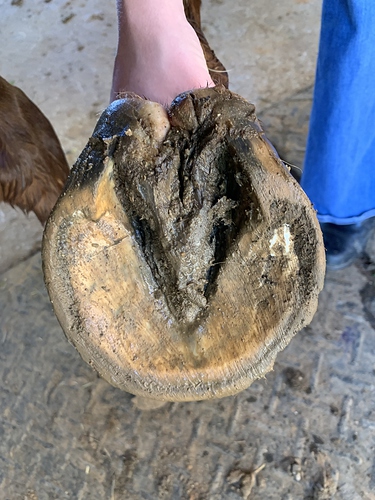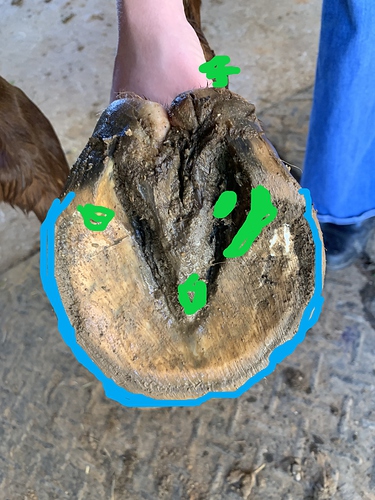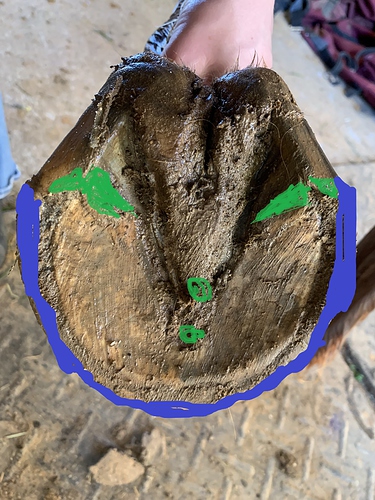I hear you about trimming being hard on your back! I’ve been guilty of getting on one knee or using a stool for the ones I know are generally good eggs. Not the safest choice, which I own, but it saves my back.
A hoof jack/stand would be a very good tool–personally, my ankles are shot so I can’t hold feet between my legs. I need them to cooperate with a hoof jack to some extent, and I can use the hand not holding a rasp to gently brace the foot. You’ll find the easiest way that works with your conformation in time.
What brand of rasp do you have available to you? I started out with a Heller Red Tang, but have switched to Save Edge (they might be out of business now, I’m not sure) and now ultimately a Bellota Top Sharp. I do also have an angle grinder that is a lifesaver on some of the big lugs I trim! I also really like my little bonsai nippers for trimming frogs, bars, and heels. I’d use them here to clean up the bars a bit and lightly trim some of the heel back. I’ll see if I can doodle on the pictures to show where I’d use them.
Good/bad news, in the photos the wall separation doesn’t look as bad as I expected  If you can get your hands on a hoofjack, or can comfortably draw the foot forward against your thigh, I would probably try trimming some of this from the top. Especially while he transitions, you don’t necessarily want to take height, but you do want to bevel the walls. I’ve found sometimes this is easier to accomplish from the top because you can put a bit more force into it.
If you can get your hands on a hoofjack, or can comfortably draw the foot forward against your thigh, I would probably try trimming some of this from the top. Especially while he transitions, you don’t necessarily want to take height, but you do want to bevel the walls. I’ve found sometimes this is easier to accomplish from the top because you can put a bit more force into it.
Do you have something to help tackle the thrushy looking frog in the left picture?

 .
.

 If you can get your hands on a hoofjack, or can comfortably draw the foot forward against your thigh, I would probably try trimming some of this from the top. Especially while he transitions, you don’t necessarily want to take height, but you do want to bevel the walls. I’ve found sometimes this is easier to accomplish from the top because you can put a bit more force into it.
If you can get your hands on a hoofjack, or can comfortably draw the foot forward against your thigh, I would probably try trimming some of this from the top. Especially while he transitions, you don’t necessarily want to take height, but you do want to bevel the walls. I’ve found sometimes this is easier to accomplish from the top because you can put a bit more force into it. ). The younger one I don’t trust as he’s all over the place and still prone to slamming a foot down/arguing a bit about who owns the foot at any given moment. Aka - hoof stand.
). The younger one I don’t trust as he’s all over the place and still prone to slamming a foot down/arguing a bit about who owns the foot at any given moment. Aka - hoof stand.

